Business Finance Project: Investment Decision and Dividend Policy
VerifiedAdded on 2022/11/13
|8
|1946
|324
Project
AI Summary
This project analyzes a business finance case, evaluating an investment decision and dividend policy. Part A focuses on an investment decision for a new product, including calculating Net Present Value (NPV), Internal Rate of Return (IRR), payback period, and profitability index to assess the project's financial viability. The analysis incorporates relevant cash flows, depreciation, and various assumptions. Part B delves into dividend policy, examining the Dividend Irrelevance Theory by Modigliani and Miller, exploring its assumptions, arguments, and criticisms. The project assesses the theory's applicability in the real world, considering factors like taxes, transaction costs, and leverage, and highlights the limitations of the theory's assumptions. The project references several sources to support its findings.
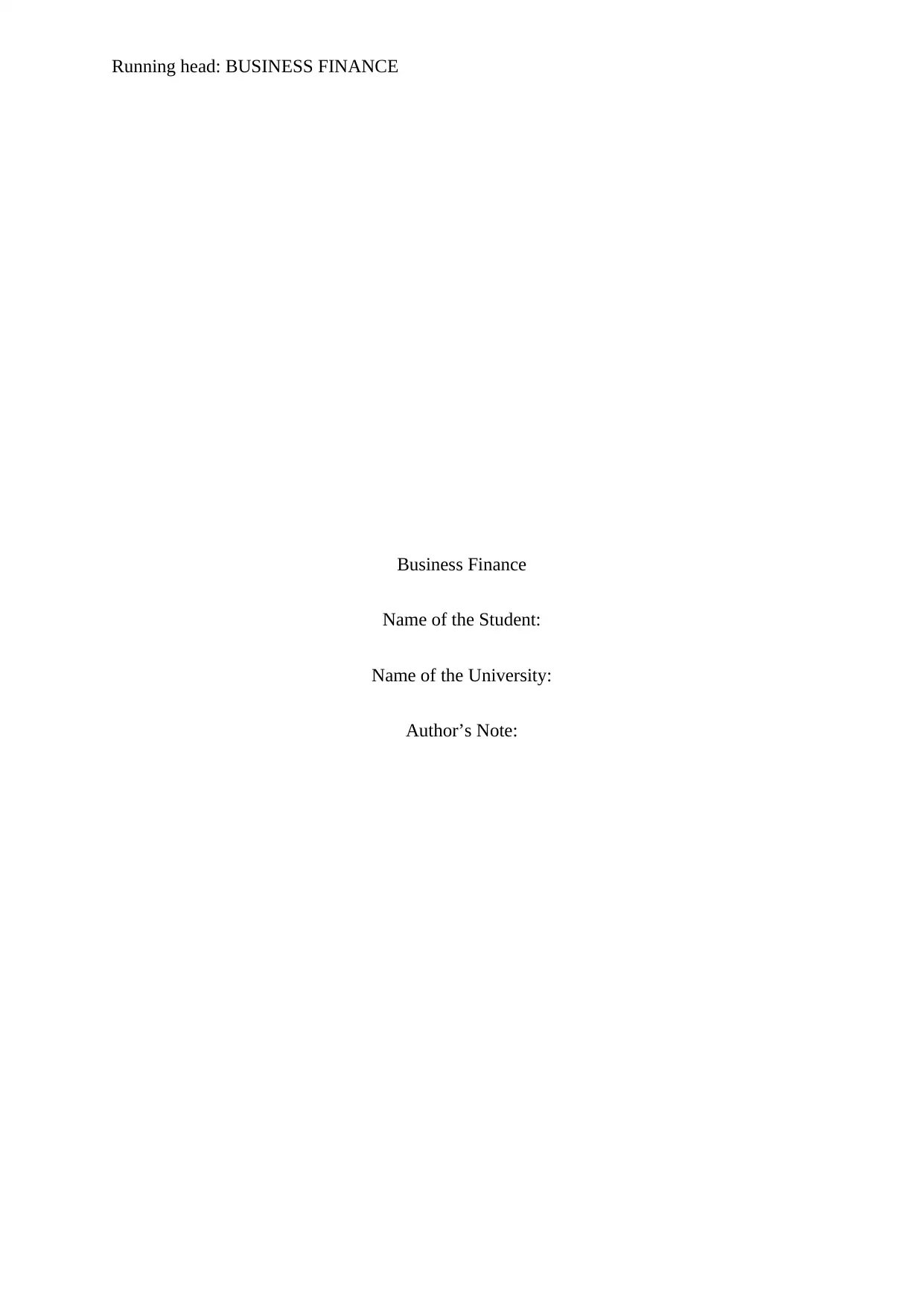
Running head: BUSINESS FINANCE
Business Finance
Name of the Student:
Name of the University:
Author’s Note:
Business Finance
Name of the Student:
Name of the University:
Author’s Note:
Paraphrase This Document
Need a fresh take? Get an instant paraphrase of this document with our AI Paraphraser
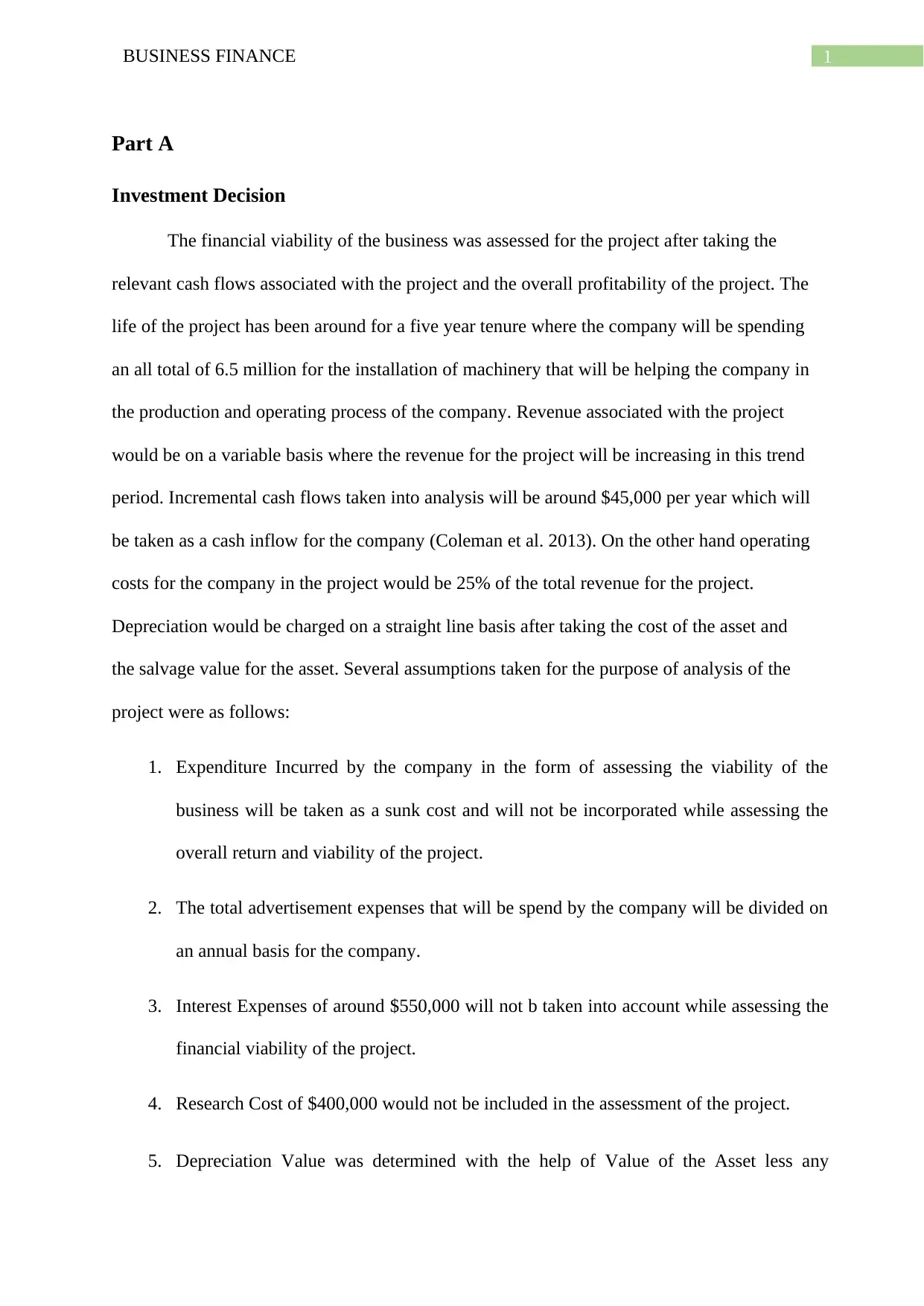
1BUSINESS FINANCE
Part A
Investment Decision
The financial viability of the business was assessed for the project after taking the
relevant cash flows associated with the project and the overall profitability of the project. The
life of the project has been around for a five year tenure where the company will be spending
an all total of 6.5 million for the installation of machinery that will be helping the company in
the production and operating process of the company. Revenue associated with the project
would be on a variable basis where the revenue for the project will be increasing in this trend
period. Incremental cash flows taken into analysis will be around $45,000 per year which will
be taken as a cash inflow for the company (Coleman et al. 2013). On the other hand operating
costs for the company in the project would be 25% of the total revenue for the project.
Depreciation would be charged on a straight line basis after taking the cost of the asset and
the salvage value for the asset. Several assumptions taken for the purpose of analysis of the
project were as follows:
1. Expenditure Incurred by the company in the form of assessing the viability of the
business will be taken as a sunk cost and will not be incorporated while assessing the
overall return and viability of the project.
2. The total advertisement expenses that will be spend by the company will be divided on
an annual basis for the company.
3. Interest Expenses of around $550,000 will not b taken into account while assessing the
financial viability of the project.
4. Research Cost of $400,000 would not be included in the assessment of the project.
5. Depreciation Value was determined with the help of Value of the Asset less any
Part A
Investment Decision
The financial viability of the business was assessed for the project after taking the
relevant cash flows associated with the project and the overall profitability of the project. The
life of the project has been around for a five year tenure where the company will be spending
an all total of 6.5 million for the installation of machinery that will be helping the company in
the production and operating process of the company. Revenue associated with the project
would be on a variable basis where the revenue for the project will be increasing in this trend
period. Incremental cash flows taken into analysis will be around $45,000 per year which will
be taken as a cash inflow for the company (Coleman et al. 2013). On the other hand operating
costs for the company in the project would be 25% of the total revenue for the project.
Depreciation would be charged on a straight line basis after taking the cost of the asset and
the salvage value for the asset. Several assumptions taken for the purpose of analysis of the
project were as follows:
1. Expenditure Incurred by the company in the form of assessing the viability of the
business will be taken as a sunk cost and will not be incorporated while assessing the
overall return and viability of the project.
2. The total advertisement expenses that will be spend by the company will be divided on
an annual basis for the company.
3. Interest Expenses of around $550,000 will not b taken into account while assessing the
financial viability of the project.
4. Research Cost of $400,000 would not be included in the assessment of the project.
5. Depreciation Value was determined with the help of Value of the Asset less any
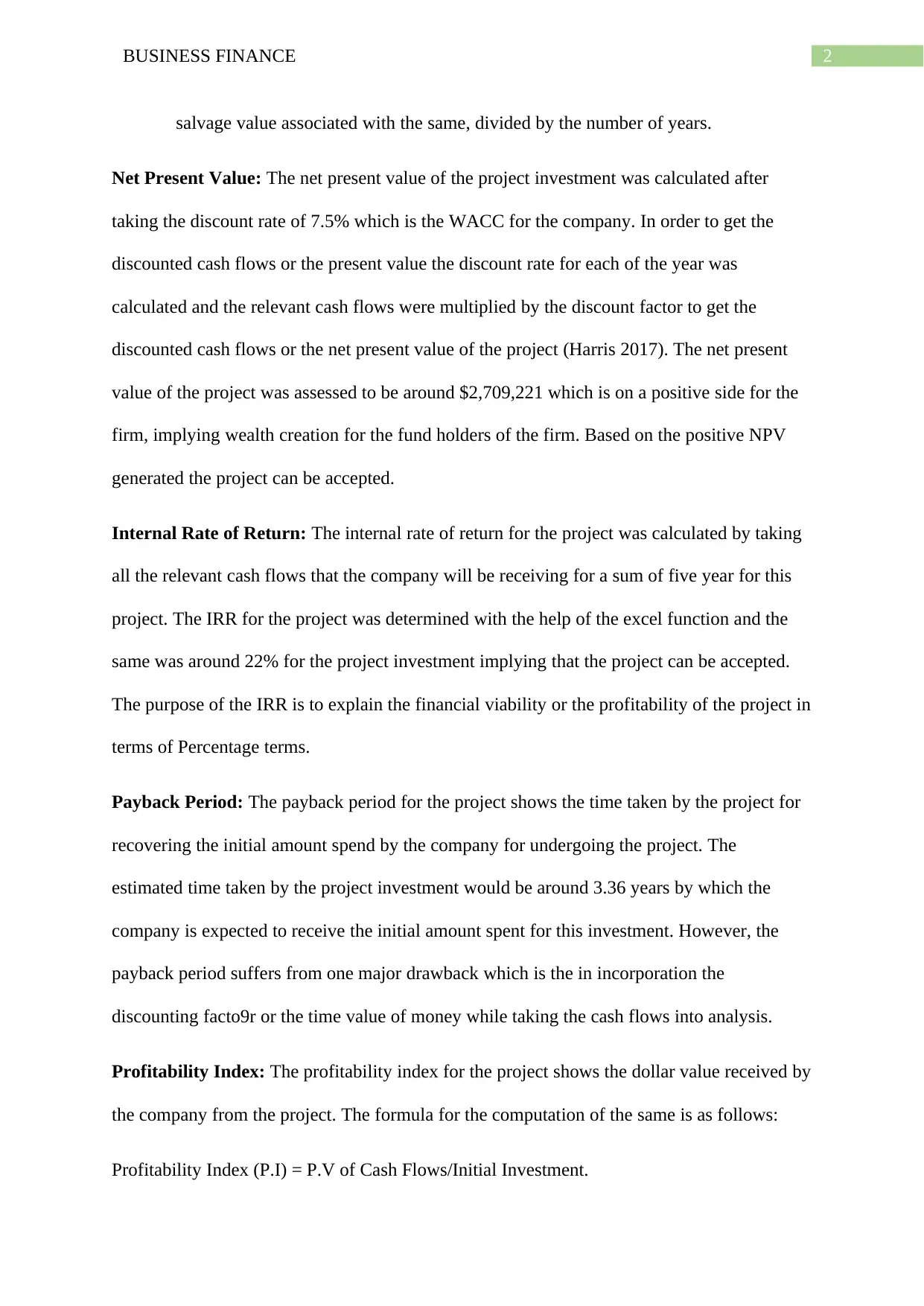
2BUSINESS FINANCE
salvage value associated with the same, divided by the number of years.
Net Present Value: The net present value of the project investment was calculated after
taking the discount rate of 7.5% which is the WACC for the company. In order to get the
discounted cash flows or the present value the discount rate for each of the year was
calculated and the relevant cash flows were multiplied by the discount factor to get the
discounted cash flows or the net present value of the project (Harris 2017). The net present
value of the project was assessed to be around $2,709,221 which is on a positive side for the
firm, implying wealth creation for the fund holders of the firm. Based on the positive NPV
generated the project can be accepted.
Internal Rate of Return: The internal rate of return for the project was calculated by taking
all the relevant cash flows that the company will be receiving for a sum of five year for this
project. The IRR for the project was determined with the help of the excel function and the
same was around 22% for the project investment implying that the project can be accepted.
The purpose of the IRR is to explain the financial viability or the profitability of the project in
terms of Percentage terms.
Payback Period: The payback period for the project shows the time taken by the project for
recovering the initial amount spend by the company for undergoing the project. The
estimated time taken by the project investment would be around 3.36 years by which the
company is expected to receive the initial amount spent for this investment. However, the
payback period suffers from one major drawback which is the in incorporation the
discounting facto9r or the time value of money while taking the cash flows into analysis.
Profitability Index: The profitability index for the project shows the dollar value received by
the company from the project. The formula for the computation of the same is as follows:
Profitability Index (P.I) = P.V of Cash Flows/Initial Investment.
salvage value associated with the same, divided by the number of years.
Net Present Value: The net present value of the project investment was calculated after
taking the discount rate of 7.5% which is the WACC for the company. In order to get the
discounted cash flows or the present value the discount rate for each of the year was
calculated and the relevant cash flows were multiplied by the discount factor to get the
discounted cash flows or the net present value of the project (Harris 2017). The net present
value of the project was assessed to be around $2,709,221 which is on a positive side for the
firm, implying wealth creation for the fund holders of the firm. Based on the positive NPV
generated the project can be accepted.
Internal Rate of Return: The internal rate of return for the project was calculated by taking
all the relevant cash flows that the company will be receiving for a sum of five year for this
project. The IRR for the project was determined with the help of the excel function and the
same was around 22% for the project investment implying that the project can be accepted.
The purpose of the IRR is to explain the financial viability or the profitability of the project in
terms of Percentage terms.
Payback Period: The payback period for the project shows the time taken by the project for
recovering the initial amount spend by the company for undergoing the project. The
estimated time taken by the project investment would be around 3.36 years by which the
company is expected to receive the initial amount spent for this investment. However, the
payback period suffers from one major drawback which is the in incorporation the
discounting facto9r or the time value of money while taking the cash flows into analysis.
Profitability Index: The profitability index for the project shows the dollar value received by
the company from the project. The formula for the computation of the same is as follows:
Profitability Index (P.I) = P.V of Cash Flows/Initial Investment.
⊘ This is a preview!⊘
Do you want full access?
Subscribe today to unlock all pages.

Trusted by 1+ million students worldwide
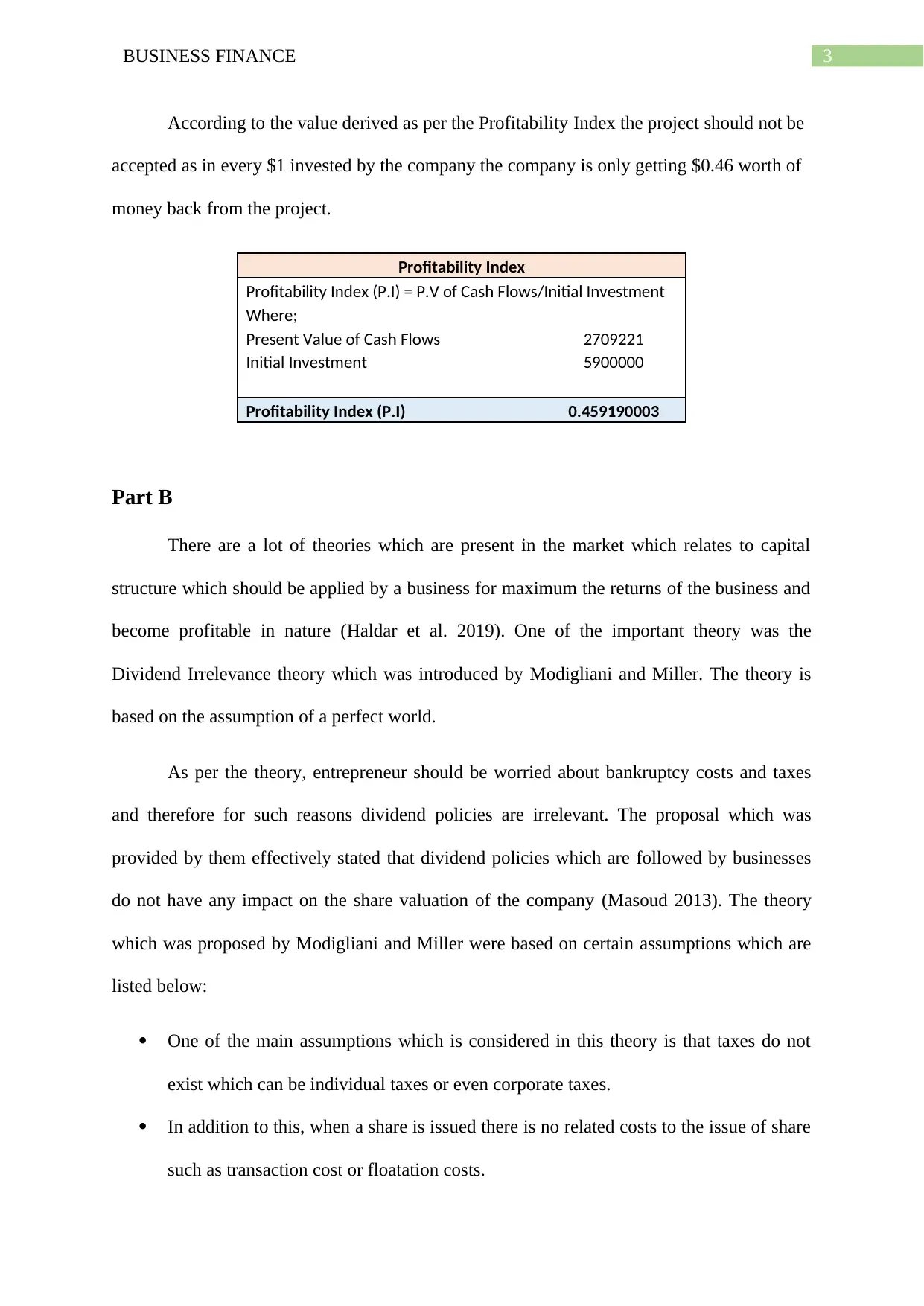
3BUSINESS FINANCE
According to the value derived as per the Profitability Index the project should not be
accepted as in every $1 invested by the company the company is only getting $0.46 worth of
money back from the project.
Profitability Index
Profitability Index (P.I) = P.V of Cash Flows/Initial Investment
Where;
Present Value of Cash Flows 2709221
Initial Investment 5900000
Profitability Index (P.I) 0.459190003
Part B
There are a lot of theories which are present in the market which relates to capital
structure which should be applied by a business for maximum the returns of the business and
become profitable in nature (Haldar et al. 2019). One of the important theory was the
Dividend Irrelevance theory which was introduced by Modigliani and Miller. The theory is
based on the assumption of a perfect world.
As per the theory, entrepreneur should be worried about bankruptcy costs and taxes
and therefore for such reasons dividend policies are irrelevant. The proposal which was
provided by them effectively stated that dividend policies which are followed by businesses
do not have any impact on the share valuation of the company (Masoud 2013). The theory
which was proposed by Modigliani and Miller were based on certain assumptions which are
listed below:
One of the main assumptions which is considered in this theory is that taxes do not
exist which can be individual taxes or even corporate taxes.
In addition to this, when a share is issued there is no related costs to the issue of share
such as transaction cost or floatation costs.
According to the value derived as per the Profitability Index the project should not be
accepted as in every $1 invested by the company the company is only getting $0.46 worth of
money back from the project.
Profitability Index
Profitability Index (P.I) = P.V of Cash Flows/Initial Investment
Where;
Present Value of Cash Flows 2709221
Initial Investment 5900000
Profitability Index (P.I) 0.459190003
Part B
There are a lot of theories which are present in the market which relates to capital
structure which should be applied by a business for maximum the returns of the business and
become profitable in nature (Haldar et al. 2019). One of the important theory was the
Dividend Irrelevance theory which was introduced by Modigliani and Miller. The theory is
based on the assumption of a perfect world.
As per the theory, entrepreneur should be worried about bankruptcy costs and taxes
and therefore for such reasons dividend policies are irrelevant. The proposal which was
provided by them effectively stated that dividend policies which are followed by businesses
do not have any impact on the share valuation of the company (Masoud 2013). The theory
which was proposed by Modigliani and Miller were based on certain assumptions which are
listed below:
One of the main assumptions which is considered in this theory is that taxes do not
exist which can be individual taxes or even corporate taxes.
In addition to this, when a share is issued there is no related costs to the issue of share
such as transaction cost or floatation costs.
Paraphrase This Document
Need a fresh take? Get an instant paraphrase of this document with our AI Paraphraser
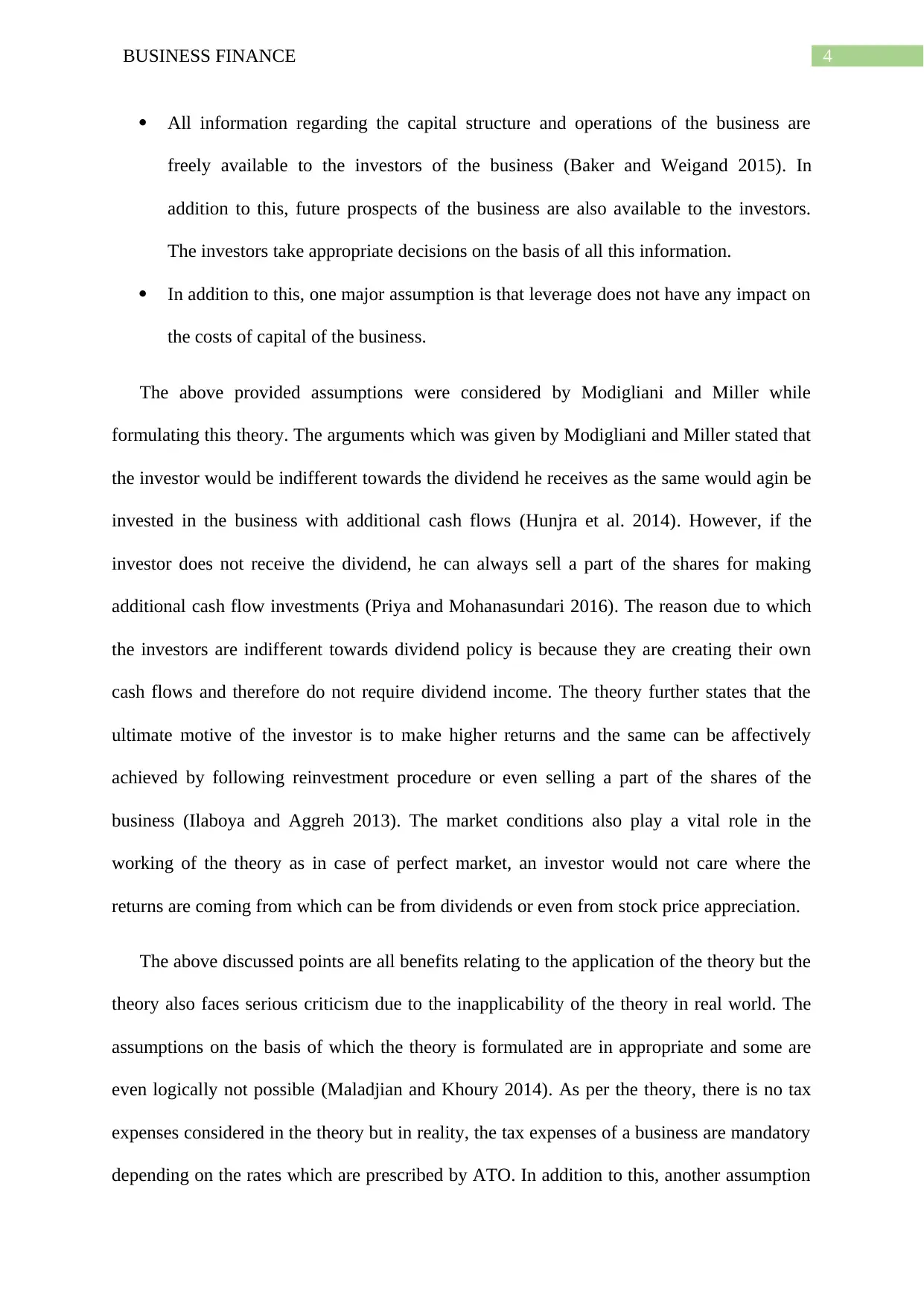
4BUSINESS FINANCE
All information regarding the capital structure and operations of the business are
freely available to the investors of the business (Baker and Weigand 2015). In
addition to this, future prospects of the business are also available to the investors.
The investors take appropriate decisions on the basis of all this information.
In addition to this, one major assumption is that leverage does not have any impact on
the costs of capital of the business.
The above provided assumptions were considered by Modigliani and Miller while
formulating this theory. The arguments which was given by Modigliani and Miller stated that
the investor would be indifferent towards the dividend he receives as the same would agin be
invested in the business with additional cash flows (Hunjra et al. 2014). However, if the
investor does not receive the dividend, he can always sell a part of the shares for making
additional cash flow investments (Priya and Mohanasundari 2016). The reason due to which
the investors are indifferent towards dividend policy is because they are creating their own
cash flows and therefore do not require dividend income. The theory further states that the
ultimate motive of the investor is to make higher returns and the same can be affectively
achieved by following reinvestment procedure or even selling a part of the shares of the
business (Ilaboya and Aggreh 2013). The market conditions also play a vital role in the
working of the theory as in case of perfect market, an investor would not care where the
returns are coming from which can be from dividends or even from stock price appreciation.
The above discussed points are all benefits relating to the application of the theory but the
theory also faces serious criticism due to the inapplicability of the theory in real world. The
assumptions on the basis of which the theory is formulated are in appropriate and some are
even logically not possible (Maladjian and Khoury 2014). As per the theory, there is no tax
expenses considered in the theory but in reality, the tax expenses of a business are mandatory
depending on the rates which are prescribed by ATO. In addition to this, another assumption
All information regarding the capital structure and operations of the business are
freely available to the investors of the business (Baker and Weigand 2015). In
addition to this, future prospects of the business are also available to the investors.
The investors take appropriate decisions on the basis of all this information.
In addition to this, one major assumption is that leverage does not have any impact on
the costs of capital of the business.
The above provided assumptions were considered by Modigliani and Miller while
formulating this theory. The arguments which was given by Modigliani and Miller stated that
the investor would be indifferent towards the dividend he receives as the same would agin be
invested in the business with additional cash flows (Hunjra et al. 2014). However, if the
investor does not receive the dividend, he can always sell a part of the shares for making
additional cash flow investments (Priya and Mohanasundari 2016). The reason due to which
the investors are indifferent towards dividend policy is because they are creating their own
cash flows and therefore do not require dividend income. The theory further states that the
ultimate motive of the investor is to make higher returns and the same can be affectively
achieved by following reinvestment procedure or even selling a part of the shares of the
business (Ilaboya and Aggreh 2013). The market conditions also play a vital role in the
working of the theory as in case of perfect market, an investor would not care where the
returns are coming from which can be from dividends or even from stock price appreciation.
The above discussed points are all benefits relating to the application of the theory but the
theory also faces serious criticism due to the inapplicability of the theory in real world. The
assumptions on the basis of which the theory is formulated are in appropriate and some are
even logically not possible (Maladjian and Khoury 2014). As per the theory, there is no tax
expenses considered in the theory but in reality, the tax expenses of a business are mandatory
depending on the rates which are prescribed by ATO. In addition to this, another assumption
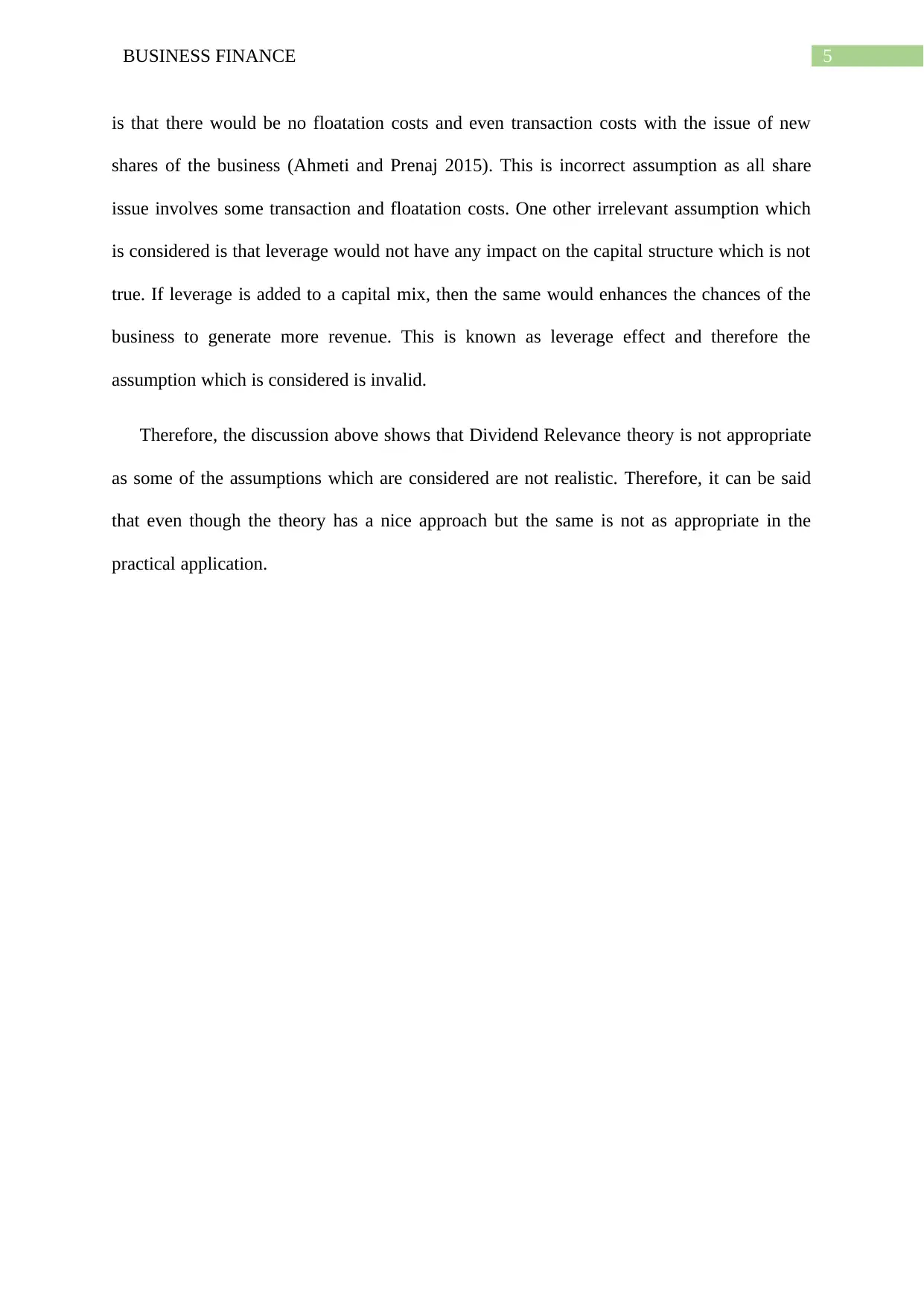
5BUSINESS FINANCE
is that there would be no floatation costs and even transaction costs with the issue of new
shares of the business (Ahmeti and Prenaj 2015). This is incorrect assumption as all share
issue involves some transaction and floatation costs. One other irrelevant assumption which
is considered is that leverage would not have any impact on the capital structure which is not
true. If leverage is added to a capital mix, then the same would enhances the chances of the
business to generate more revenue. This is known as leverage effect and therefore the
assumption which is considered is invalid.
Therefore, the discussion above shows that Dividend Relevance theory is not appropriate
as some of the assumptions which are considered are not realistic. Therefore, it can be said
that even though the theory has a nice approach but the same is not as appropriate in the
practical application.
is that there would be no floatation costs and even transaction costs with the issue of new
shares of the business (Ahmeti and Prenaj 2015). This is incorrect assumption as all share
issue involves some transaction and floatation costs. One other irrelevant assumption which
is considered is that leverage would not have any impact on the capital structure which is not
true. If leverage is added to a capital mix, then the same would enhances the chances of the
business to generate more revenue. This is known as leverage effect and therefore the
assumption which is considered is invalid.
Therefore, the discussion above shows that Dividend Relevance theory is not appropriate
as some of the assumptions which are considered are not realistic. Therefore, it can be said
that even though the theory has a nice approach but the same is not as appropriate in the
practical application.
⊘ This is a preview!⊘
Do you want full access?
Subscribe today to unlock all pages.

Trusted by 1+ million students worldwide

6BUSINESS FINANCE
Reference
Ahmeti, F. and Prenaj, B., 2015. A critical review of Modigliani and Miller’s theorem of
capital structure. International Journal of Economics, Commerce and Management
(IJECM), 3(6).
Baker, H.K. and Weigand, R., 2015. Corporate dividend policy revisited. Managerial
Finance, 41(2), pp.126-144.
Coleman, C., Crosby, N., McAllister, P. and Wyatt, P., 2013. Development appraisal in
practice: some evidence from the planning system. Journal of Property Research, 30(2),
pp.144-165.
G, A., Haldar, S., Haldar, S. and Kristan Wojnar, R. (2019). Dividend Irrelevance Theory.
[online] Dividend.com. Available at:
https://www.dividend.com/dividend-education/dividend-irrelevance-theory/ [Accessed 28
May 2019].
Harris, E., 2017. Strategic project risk appraisal and management. Routledge.
Hunjra, A.I., Ijaz, M., Chani, D., Irfan, M. and Mustafa, U., 2014. Impact of Dividend Policy,
Earning per Share, Return on Equity, Profit after Tax on Stock Prices. Hunjra, AI, Ijaz, M. S,
Chani, MI, Hassan, S. and Mustafa, U.(2014). Impact of Dividend Policy, Earning per Share,
Return on Equity, Profit after Tax on Stock Prices. International Journal of Economics and
Empirical Research, 2(3), pp.109-115.
Ilaboya, O.J. and Aggreh, M., 2013. Dividend policy and share price volatility. Journal of
Asian Development.
Reference
Ahmeti, F. and Prenaj, B., 2015. A critical review of Modigliani and Miller’s theorem of
capital structure. International Journal of Economics, Commerce and Management
(IJECM), 3(6).
Baker, H.K. and Weigand, R., 2015. Corporate dividend policy revisited. Managerial
Finance, 41(2), pp.126-144.
Coleman, C., Crosby, N., McAllister, P. and Wyatt, P., 2013. Development appraisal in
practice: some evidence from the planning system. Journal of Property Research, 30(2),
pp.144-165.
G, A., Haldar, S., Haldar, S. and Kristan Wojnar, R. (2019). Dividend Irrelevance Theory.
[online] Dividend.com. Available at:
https://www.dividend.com/dividend-education/dividend-irrelevance-theory/ [Accessed 28
May 2019].
Harris, E., 2017. Strategic project risk appraisal and management. Routledge.
Hunjra, A.I., Ijaz, M., Chani, D., Irfan, M. and Mustafa, U., 2014. Impact of Dividend Policy,
Earning per Share, Return on Equity, Profit after Tax on Stock Prices. Hunjra, AI, Ijaz, M. S,
Chani, MI, Hassan, S. and Mustafa, U.(2014). Impact of Dividend Policy, Earning per Share,
Return on Equity, Profit after Tax on Stock Prices. International Journal of Economics and
Empirical Research, 2(3), pp.109-115.
Ilaboya, O.J. and Aggreh, M., 2013. Dividend policy and share price volatility. Journal of
Asian Development.
Paraphrase This Document
Need a fresh take? Get an instant paraphrase of this document with our AI Paraphraser
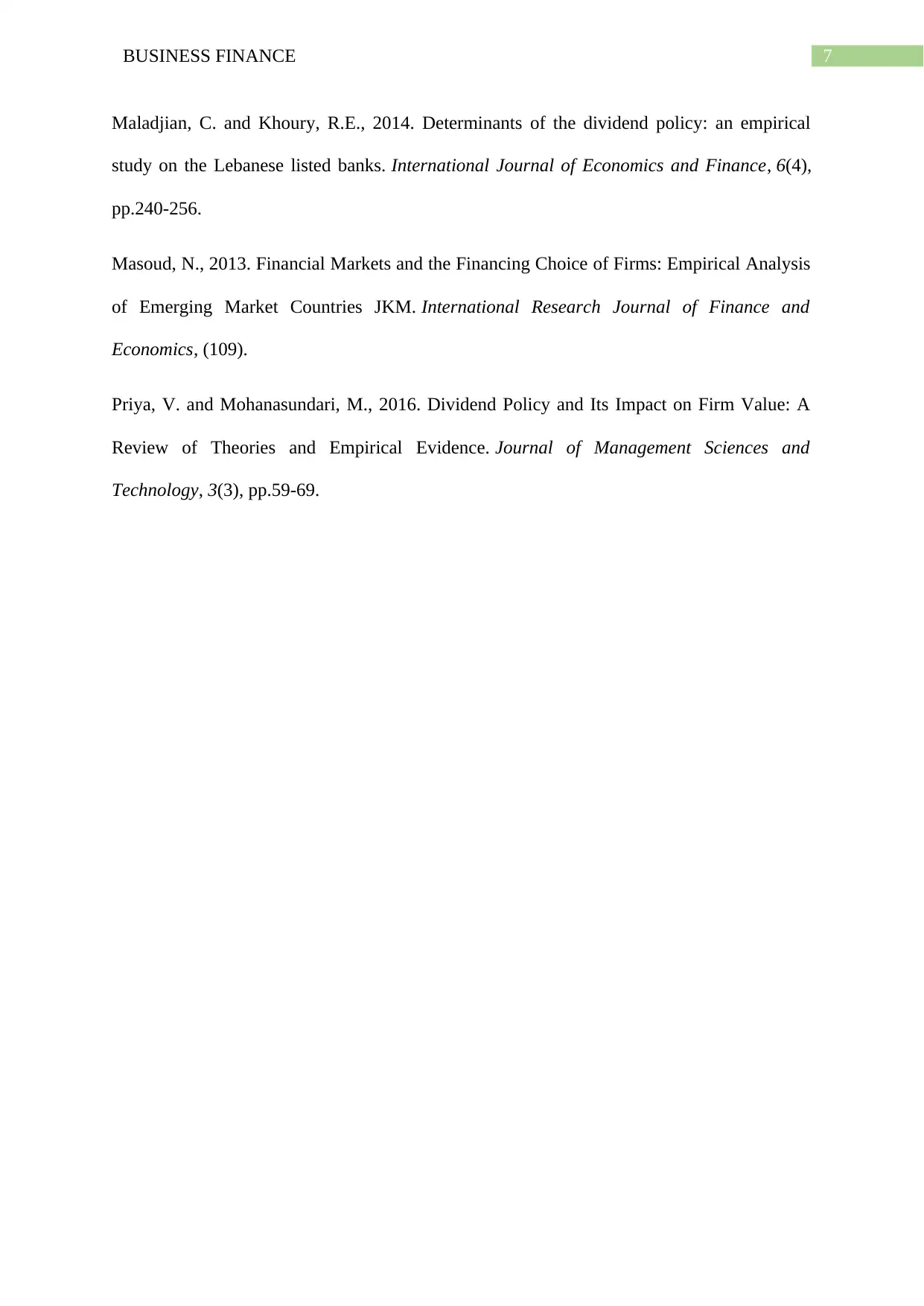
7BUSINESS FINANCE
Maladjian, C. and Khoury, R.E., 2014. Determinants of the dividend policy: an empirical
study on the Lebanese listed banks. International Journal of Economics and Finance, 6(4),
pp.240-256.
Masoud, N., 2013. Financial Markets and the Financing Choice of Firms: Empirical Analysis
of Emerging Market Countries JKM. International Research Journal of Finance and
Economics, (109).
Priya, V. and Mohanasundari, M., 2016. Dividend Policy and Its Impact on Firm Value: A
Review of Theories and Empirical Evidence. Journal of Management Sciences and
Technology, 3(3), pp.59-69.
Maladjian, C. and Khoury, R.E., 2014. Determinants of the dividend policy: an empirical
study on the Lebanese listed banks. International Journal of Economics and Finance, 6(4),
pp.240-256.
Masoud, N., 2013. Financial Markets and the Financing Choice of Firms: Empirical Analysis
of Emerging Market Countries JKM. International Research Journal of Finance and
Economics, (109).
Priya, V. and Mohanasundari, M., 2016. Dividend Policy and Its Impact on Firm Value: A
Review of Theories and Empirical Evidence. Journal of Management Sciences and
Technology, 3(3), pp.59-69.
1 out of 8
Related Documents
Your All-in-One AI-Powered Toolkit for Academic Success.
+13062052269
info@desklib.com
Available 24*7 on WhatsApp / Email
![[object Object]](/_next/static/media/star-bottom.7253800d.svg)
Unlock your academic potential
Copyright © 2020–2025 A2Z Services. All Rights Reserved. Developed and managed by ZUCOL.





